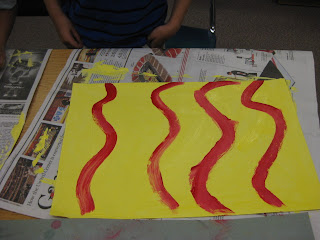This week (week two), the children could either draw freehand or use stencils to cut butterfly wings out of the painted paper they had created. We pooled all the painted papers together and the children did a great job of sharing them with each other. After they had cut out four wings and a body, they glued down the parts onto clean paper. We looked at photographs of butterflies and talked about symmetry, and then the children embellished their wings with spots and other free-form shapes. For a final step, they could add a little splash of sequins to their collage.
And here are the completed butterflies - I wish the real ones in our neighborhood were this colorful!:
It has been a great honor to be able to work with your children this year, to watch their confidence and abilities grow, and to be able to help nurture in them an appreciation for art and art-making!
Please have a fun and safe summer!
All the best,
Lucy Zucaro
(lesson credit: http://www.deepspacesparkle.com/)
































